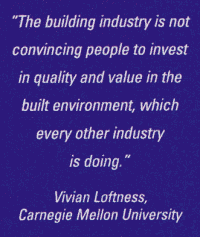Ever since Michael Hammer, the guru of Business Process Re-engineering, made the observation years ago that the business world has not adequately considered the effect re-engineering has on the notion of workplace, work space design experts have struggled to understand the relationship between the two concepts. What role does workspace really play in productivity? Can efforts to re-engineer business processes be successful if they only bring about change in human resources and information technology applications and not in the physical space where work is done, be it offices, home offices, plant floors or shared facilities?
The consensus seems to be that including workspace issues is central to improving business
processes. But to get more specific, it’s necessary to measure workplace performance in order to quantify its role. Otherwise, it’s just a concept. Determining ways to do just that was the topic of a recent IIDA (International Interior Design Assoc.) Facilities Planning & Design Forum Seminar, “Measuring Workplace Performance — The Workplace at the Millennium,” which was held on March 8, 2000, at the Steles Work Life Center, in New York City. The event was organized by Brennan Beer Gorman Monk/Interiors, an architecture and design firm headquartered in New York.

What Drives Real Estate Decisions?
“The 1990s were very much about technology, say people in the technology world,” observed Jack Tanis, director of Business Development at Steelcase. “The focus now is on people, and you can’t deal effectively with people issues without dealing with place issues. So the time ahead of us will be much more fertile for those of us working on space design issues.”
One place to start, noted Tanis, is to determine what drives work space, or real estate, decisions — effectiveness (doing the right thing) or efficiency (doing things the right way)? The ideal answer is a blend of the two, doing the right things the right way, wherein customers, employees and management all benefit. “But we must realize that the real estate community is driven by real estate efficiency,” Tanis pointed out, which is at least easier to measure than effectiveness.
Much work in the area of measuring workspace efficiency is being done at Carnegie Mellon University’s Dept. of Architecture. Vivian Loftness, who heads the department and directs its Center for Building Performance and Diagnostics, also spoke at the IIDA event. “The building industry is in deep trouble right now, because we are not convincing people to invest in quality and value in the built environment, which every other industry is doing,” Loftness pointed out. One of the values that is being marketed with some success is what she refers to as layers of collaboration — formal and informal alliances of, say, service providers, that add value to the users of built environments.
“We also have to invest in layers of ownership, understanding that people need to work in shared and individual spaces, in spaces around the country because people are very mobile, and we need to understand that we are investing in layers of ownership,” she related. “We need to invest in ergonomics for individual work processes and for shared work processes, as well as in layers of personalization due to the tremendous variation in the kinds of tasks people are doing and the materials they require. The key is flexible infrastructure and flexible furniture systems that can evolve from one end of the spectrum to the other.” Such investments in the work environment add value for all users of that environment, which increases productivity and efficiency. Loftness makes the point that consumers of such mass produced goods as automobiles are willing to pay more for added value, but real estate remains an expense item to be reduced in the minds of many work space users.
“We need to invest in technological infrastructure to support the dynamic nature of work, and we need to show value in long-term, resource-conserving work environments — ones that have higher quality materials that allow for just-in-time purchasing of upgrades and regeneration as the organization evolves,” Loftness added. “You should be able to differentiate quickly when you’ve bought a low-quality material that can’t regenerate and high quality one that can.”
Quantifying Organizational Savings
 These factors, and others Loftness outlined at the seminar, should enhance the value of properties. But viewing the value of workspace in such terms is a nascent field, she acknowledges. “The issue is not just what the measures of value are, but how do you convince the investor to put the money behind it?”
These factors, and others Loftness outlined at the seminar, should enhance the value of properties. But viewing the value of workspace in such terms is a nascent field, she acknowledges. “The issue is not just what the measures of value are, but how do you convince the investor to put the money behind it?”
Carnegie Mellon’s Center for Building Performance and Diagnostics, in conjunction with Steelcase and other industry parties, has developed a tool known as BIDS (Building Investment Decision Support). The system helps identify life cycle costs that should help cost justify first-time investment in workspace value and quality, Loftness explains. Among other benefits, BIDS quantifies savings in operations and facilities management costs, individual productivity costs, organizational productivity costs, health costs, attraction and retention costs, organizational renewability costs, and several other areas.
The research is based on approximately 40 case studies that demonstrate an entirely new economic value added in the built environment, Loftness points out. This research and other initiatives at the Center for Building Performance and Diagnostics will be the subject of an article to be written by Prof. Loftness, which will appear in a forthcoming issue of Site Selection.
Other speakers on the seminar panel were Stephen Silverstein, director of real estate, facilities & administration, at Deloitte & Touche; Eileen Harvard, director of workplace strategies and solutions at Citibank, N.A.; and Rick Fochy, TITLE, COMPANY. Their input will be covered in the next issue of Site Selection. The moderator was Roger Yee, former editorial director of the Miller Freeman Design Group.

